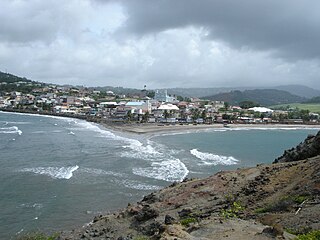Sainte-Marie, nestled on the northeastern coast of Martinique, stands as a beacon of Creole culture and natural beauty. This charming locale offers a blend of historical depth and lush landscapes, making it a captivating destination for travelers. Visitors can explore its rich banana plantations, rum distilleries, and vibrant cultural festivals. The town is also home to the famous Tombolo, a natural sandy causeway, and museums that delve into the island’s pre-Columbian and colonial past, providing a comprehensive cultural experience amidst scenic surroundings.
Ensure to visit during the Fête du Crab et de la Mangue, held in April, where you can experience local cuisine and cultural performances unique to Sainte-Marie.
Consider a guided tour of the Saint James Rum Distillery to learn about traditional rum production and enjoy tastings of various aged rums.
Sainte-Marie: A Touch of French Caribbean Charm
| Country | Martinique (France) |
| Time in Sainte-Marie | GMT-4 |
| Language spoken | French |
| Population | 20,380 (Last updated 2021, Source: INSEE) |
| Currency | Euro (€, EUR) |
| Airports |
|
Sainte-Marie, nestled in the lush landscapes of Martinique, represents a vibrant blend of cultural heritage and natural beauty. This town, an integral part of Martinique’s rich history, offers visitors an authentic glimpse into the island’s past and present. As a region influenced by both French and Caribbean cultures, Sainte-Marie stands out with its distinctive traditions, cuisine, and language.
Where is Sainte-Marie?
Sainte-Marie is located on the northeastern coast of Martinique, facing the Atlantic Ocean, offering scenic views and a breezy climate.
Distances:
| Route | Distance by car | Time by car |
|---|---|---|
| Fort-de-France to Sainte-Marie | 22 miles (35 km) | 45 minutes |
| Le Lamentin to Sainte-Marie | 16 miles (25 km) | 40 minutes |
| Le François to Sainte-Marie | 17 miles (27 km) | 30 minutes |
What is Sainte-Marie famous for?
Sainte-Marie is renowned for its “Banana Museum” which explores banana cultivation’s impact on the island and features extensive banana plantations. This quaint town is also known for hosting the exciting annual ‘Fête des Cuisinières’, celebrating Creole cuisine.
History
Pre-Colonial Period (Before 1500)
The island of Martinique, where Sainte-Marie is located, was originally inhabited by Arawak and then Carib peoples. These indigenous communities thrived on fishing, agriculture, and the development of pottery and weaving skills.
Colonial Era (1502-1848)
In 1502, Christopher Columbus became the first European to sight Martinique during his fourth voyage. The French officially claimed Martinique in 1635, and Sainte-Marie was founded shortly thereafter. The town quickly became a bustling point for the sugar cane industry, driven by enslaved African labor. The economy heavily depended on slavery until it was abolished in 1848, profoundly impacting Sainte-Marie’s social and economic structures.
Post-Colonial Development (1848-1960)
After the abolition of slavery, Sainte-Marie underwent several changes. The introduction of Indian indentured servitude in the late 19th century brought a new cultural influence to the town. Sugar remained a dominant industry, but economic diversification began to take shape as the town expanded.
Modern Period (1960-Present)
In recent decades, Sainte-Marie has focused on diversifying its economy beyond agriculture. The town has embraced tourism, leveraging its rich historical heritage and natural beauty. Preservation efforts for historical sites have been implemented, and the town’s cultural calendar now features numerous festivals that attract visitors from across the globe.
Visit Sainte-Marie
What to see and do in Sainte-Marie, Martinique (France)
Visiting Sainte-Marie offers a rich blend of cultural history and natural scenery. Key attractions include:
- The Banana Museum, showcasing the history and cultivation of bananas in the Caribbean.
- Saint James Rum Distillery, where visitors can learn about rum production and indulge in tastings.
- Historic architecture in the town center, including the church of Sainte-Marie, which stands as a testament to the town’s colonial past.
- Nearby hiking trails and beaches that offer stunning views and serene nature escapes.
Annual Events
Sainte-Marie hosts several annual events that celebrate its rich culture and heritage:
- The Rum Festival in August, featuring local music, food, and of course, rum.
- Carnival in February or March, a vibrant display of costumes and dances reflecting the island’s cultural fusion.
These events provide a glimpse into the local traditions and are a big draw for tourists.
Best time to visit Sainte-Marie
The best time to visit Sainte-Marie is between December and April when the weather is most favorable. This period avoids the heavy rains and potential hurricanes of the wet season, making it ideal for enjoying both the cultural and outdoor activities that Sainte-Marie has to offer.
Is Sainte-Marie worth visiting?
Sainte-Marie, with its rich historical tapestry and vibrant cultural scene, offers a unique experience in Martinique. Visitors can appreciate both the natural beauty of its landscapes and the historical depth of its sites. However, it is important for potential visitors to consider the relatively undeveloped tourism infrastructure, which may not appeal to everyone. For those who appreciate a blend of history, culture, and natural beauty, and are willing to explore beyond typical tourist routes, Sainte-Marie represents a rewarding destination.








